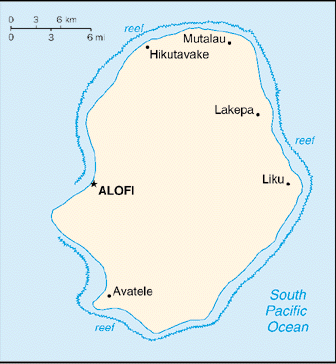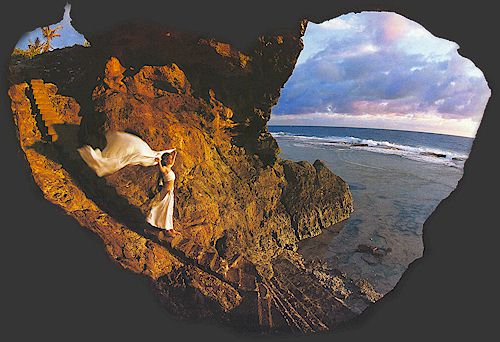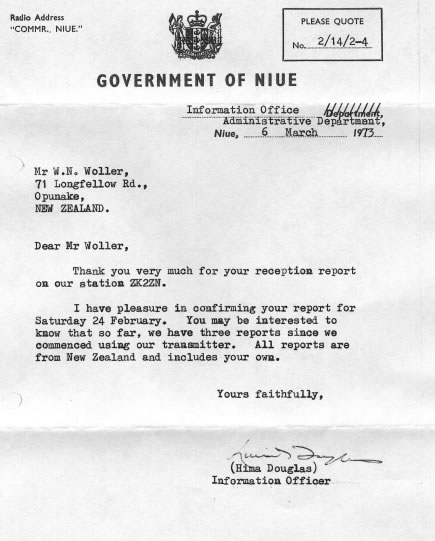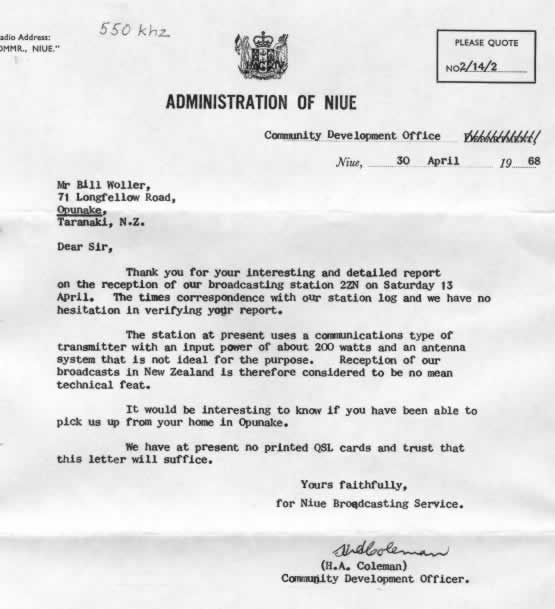You’ll find Niue (pronounced Nyou-eh) in the South Pacific to the east of Tonga. It has an area of 263 sq. km. (101 sq. miles) and a population of little more than 1750. Annexed by New Zealand in 1901, the island achieved self-government in 1974. It is reputedly one of the largest coral island in the world and like many Pacific paradises, has a thriving tourism industry.
Click the logo above to check out the”Visit Niue” web-site for more info.
Radio Sunshine
ZK2ZN or Radio Sunshine as it’s known, had been regularly heard by New Zealanders since its inception despite it’s relatively low power. MW reception became more difficult when a New Zealand station opened on the same frequency, 594kHz. ZK2ZN’s first broadcasts were on 550kHz with 200 watts, then it moved to 620kHz with 250 watts some time later. In the 1979 WARC allocations, they changed to 837kHz before settling on 594kHz though, sadly for MW DXers they moved to 91 FM about 1994.
The following details of Radio Sunshine ZK2ZN Niue come from the late Sione Jacobsen – Information Officer for the Niue Government. Sione returned to Niue to take up this position in July l983 after working with Radio NZ for 6 years.
From the June 1985 “DX Times”
The island of Niue is vulnerable to hurricanes and tropical cyclones during the so-called hurricane season, which begins in November through to April. It maybe asked what has hurricanes and tropical cyclones have to do with broadcasting? Well….., this was the whole reason why Radio Sunshine(ZK2ZN) was established as a cheap and. effective means of keeping people informed and advising them on procedures to be taken during a big blow.
During the early sixties when it was agreed that such a facility would be more then an asset it was decided to go ahead and construct a small studio equipped with the basics. New Zealand Broadcasting Corporation (NZBC) as it was known in those days recommended the equipment required and drew up a programme format that would suit local requirements. The on-air studio (there was only one ) was equipped with a half Gates mixer, two AKG microphones, a receiver rescued from a Japanese fishing boat that ran aground, one reel to reel tape-recorder and of course a clock that kept on loosing three minutes every twenty four hours and other bits and pieces.
It was all very well to have a studio but when it came to being heard someone had forgotten about the most essential piece of equipment, a transmitter. It was just as well that the local Telecommunications Department could spare the use of at certain times of the day. It became an accepted thing that they had priority over their piece of equipment and often during a programme there would be dead air and it was understood the TX was being used for ether purposes.
At that time also there were only few households that had receivers and a contract was struck with National of Japan to supply several hundred of them. These were sold to the public at wholesale prices, for instance a basic broadcast receiver was sold for $10. Despite the big sales it tapered off, this was due to the fact that if you were intending to buy a receiver it was cheaper to listen to your neighbours who would have it going at maximum volume and not a programme was missed.
About 1972 the Government bought its own broadcast transmitter with an output of 250 watts. The mast, which was 200 feet tall was assembled by a team of Radio New Zealand riggers. It was also realised at the time of installation that the earth mat had to be curtailed by fifty per cent owing to the rocky terrain of the sight. Not long after the TX was erected Radio Sunshine moved from a 2 x 2.4m room to a renovated building which more or less represented a broadcast studio, this time consisting of one on-air studio and a production and recording studio including space for its staff of five to work. Equipment this time included a CETAC ten channel mixer, National DR49 receiver, two Garrad 401 turntables, Revox reel to reel recorders(They have since been written off but still in use owing to nil replacements) two Teac cassette playback and record cassette machines and a clock that can keep the time. The production studio has an Alice 8-28 mixer with eight inputs. The Alice mixer and Cetac air conditioning unit, receiver and cassette machines were gifts from the Dutch Government so we could safely say that Radio Sunshine is operating on the good-will of the Dutch Government.
The next step in Niue’s short broadcasting history was the construction of permanent studios , this time through the generosity of the Australian Government . If the promise comes to fruition, the deal having been struck four years ago it will mean that Radio Sunshine for the first time since its establishment seventeen years ago will finally have a permanent and professionally constructed studios with technical equipment that would represent a professional organisation rather then the …. “Ho..hum what can we do if we don’t have it” attitude. Current programming consists of a straight music format, relays of international news from Radio Australia and if Radio New Zealand reception is broadcastable it is given preference, despite the fact their news is not actually written for re-broadcast as compared to its Australian counterpart. No sophisticated productions are encouraged because of the unreliability of recording equipment but straight talk programmes are recorded for re-broadcast. Radio, Sunshine is on-air for eight hours a day with a breakfast programme, lunch and evenings.
As it is with most developing countries the media is lowest of any administration priorities and this will continue to be for many more years to come, the only time it is ever thought off is when a national disaster is imminent and when it is pointed out that the request is impossible then things start happening when it all blows over its back to square one. (Via Paul Ormandy)
From the February 1984 DX Times.
The frequency change from 837 to 594 kilohertz took place on 6 February 1984 and was aimed at providing better reception in the outer villages. Villages on the upper eastern side of the island are now receiving better signals than before. The 250 watt Marconi transmitter (introduced in 1973) is still in use but studio equipment is dilapidated and should have been written off years ago. The government are waiting for developments since an undertaking from the Australian government to build ZK2ZN a new quarter-million dollar studio. The existence of WVUV programming on 594 kHz is explained as “due to a lazy habit of some of our employees relaying WVUV American Samoa when we go off the air at 9.l0pm”. (Via Bryan Clark)
Thanks to the Niue Tourism Office for permission to use this photo, map and logo.
A DXer in Niue – by Roger Baldwin (published in the October 1981 DX Times)
QTH Niue Roger Baldwin Then I moved to Niue to work about 2 years ago, I found that there was no television, a small newspaper was produced once a week and the local radio station was on air for only a few hours each day – and not at all on Sundays. So, I decided to take up shortwave listening. I wanted to keep up with developments in other countries and also some entertainment during the long evening hours of darkness in the tropics.
The island of Niue is located about 190 S and 1690W. It is just south of Samoa and 2500 km NE of Auckland, New Zealand, and is a raised coral atoll some 21 km long and 18 km wide. I live near the main village of Alofi, on top of the old atoll (56 m above sea level) and this is one of the better locations for radio reception on the island.
On arrival I found that my Sony ICF-8000 gave reasonable reception with a short antenna tied up to a handy tree. However, after a few months I decided to invest in a National Panasonic DR 49 which visiting friends were able to get for me duty free in Auckland. The price landed in Niue (including customs duty) was about NZ$500. This set is more than adequate for my needs and is useful for DX, being easy to tune and with good audio. However, spurious signal rejection is not the best and reception in SSB mode is fair. The BFO pitch is variable. I consider the set is good value for money.
The set is connected to 2 horizontal wire antennae 7 m above the ground; 1 runs for 30m towards the SE and the other for 20 m to the SW. Between the lead in wires and the set I have installed a knife switch which allows the aerials to be grounded during the tropical thunderstorms that we get up here. We are lucky to live in a fairly large clearing in the forest and so far the support poles have survived 2 near hurricanes – but not the rather hungry local borer!
The local radio station, “Sunshine Radio ZK2ZN broadcasts on 837 kHz with a power of 250 watts and the transmission hours were listed in the August “Times” . However, the exact times do depend on whether the announcer sleeps in and whether the rather ancient equipment is in working order. Other “local” stations that can be heard easily on mediumwave and shortwave include those in American and Western Samoa, Tonga, Fiji, Vanuatu, Solomon Islands and New Caledonia. Although it is relatively close, reception from Rarotonga is usually bad. Stations in Hawaii and Los Angeles do come in clearly on particular evenings. Many East Coast Australia stations can be heard clearly on mediumwave. Radio New Zealand can usually be heard satisfactorily, but is nowhere near as strong as Radio Australia.
From time to time I also 1isten to a number of utility stations ouch as WWVH which as well as having time signals, broadcasts weather information each hour. This is especially useful during the hurricane season when information from local ZK2ZN is often limited. Also information on ship and aircraft movements can be obtained from 2182 kHz and 13304 kHz respectively. There is 1 ship a month from New Zealand to Niue, and its arrival is an important local event.
I found a number of books to be especially useful to me in getting into shortwave listening and DXing. The WRTH was of course, the best overall reference and as well as frequency listings I found “Listen to the World” to be most helpful, in particular the tests of available radios. The World DX Guide edited by Jens Frost I also found to be a wide-ranging reference. The Confidential Frequency List by Oliver Ferrell was helpful in tracking down utility stations. Material prepared by Radio Netherlands is useful, as is their Media program. I find the “NZ DX Times” contains much up to date information on frequencies but would welcome a few more articles, and reviews of available equipment. The other resource which has been of help to me taking up this hobby, is the tape “Sounds of Shortwave” by Robert Grove. It explains many of the unusual sounds I have heard and also gives hints on selecting and setting up equipment.
QSL for 594kHz received in March 1985. (Credit: Paul Ormandy)
1968 QSL Letter (Credit: Bill Woller)








